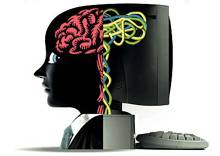What Life Might Be
Martin O'Dea
Page 2 of 6
One might ask at this juncture, ‘Why would future generations work on reviving us? Perhaps we might argue that the future generations who may be asked to work on this project, one biological generation at a time, would have the same motivation as those scientists who would undertake it now, i.e. the provisioning of their own futures.
Indicators of future possibility
Centrally, we can look at a vast amount of supporting evidence in current understandings of our physical environments, our genetic workings, and our developments in computational capabilities to support the worth of the endeavour suggested here. The following section is a brief synopsis of some of the generally held comprehensions and capabilities;
- All matter is information (whether it is a flower, a human, an atom of hydrogen or a galaxy; at its base it is distinguishable from the others mentioned here by differentials in its informational code;
- Humans and human brains are matter and so are information/or can be represented as information;
- The workings of the closed system that is the human being including its neural network etc. will be understood at a future point;
- The computational capabilities required to generate programmes or representations (infomorphs) of the entirety of a human (or any number of humans) will exist at a future point --- ‘uploading’;
- The computational ability to create a virtual realm which would be suitable for habitation by these infomorphs will exist at a future point;
- Greater understanding of DNA in the future will lead to a greater understanding of the ‘hardware’ of each individual human;
- Imaging the activity of the human brain at greater and greater resolution attains and stores greater insight into the workings, in real time, of the human brain;
- Future technologists could use the increased computational abilities to infer the total state of the human (incl. Memories) from an all inclusive representation of the human which would be stored in the present;
- Virtual realities that are malleable to the laws of physics are already being developed;
- Understanding of the genome is increasing rapidly;
- Understanding of the brains functions and applications to tasks are being understood more clearly;
- Human Memory storage is at early stages of understanding;
- Blue Gene [1] is currently attempting to ‘upload’ a mind’; and
- Mobile brain imaging devices are currently being produced.
DNA
Of course, the vast encyclopaedic information of our person’s ‘hardware’ that is our DNA is conveniently accessed and stored, and may ultimately give us the ability to revive those who are already deceased – though perhaps in the manner of an injury sufferer with total retrograde amnesia – without any memories, but with the ability to create new memories beyond the point of revitalisation. One feels that we
 |
http://www2.werkstuknetwerk.html
August 30, 2009 4:52PM EST
are at the very beginning of our knowledge of DNA and when we consign such a vast amount of it as ‘junk’ DNA we may find, as a speculative example, that in fact this is information or potential functions that have been switched off during our evolution as part of the competitive aspect of mutations and selection, and that indeed this junk DNA may prove related to our ancestral past from the beginnings of RNA [2] and carbon based-life forms. In any event, we have vast amounts to learn about our genetic make-up before we could justifiably attempt to recreate someone safe in the knowledge that this action could have unforeseen negative effects.
The Credibility of a virtual environment of the future
Perhaps we could look at an article entitled “Innovation: Physics brings realism to virtual reality” by Colin Barras [3] in New Scientists in which there is an outline of some of the current advances in the design of virtual developments and their increasing likeness with the physical world around us. This outlines an example of a virtual environment where they can ‘shoot rays’ of light in a manner comparable to our physical realm as well as, bizarrely, highlighting virtual knitting in the following words:
”Knitting garments like socks and scarves from virtual wool modeled on real-world yarn gives results that stretch and deform realistically no matter how close up the view. The results could also be used with a haptic interface to provide the feel of fabric.
To add further realism, the team now plans to simulate the fuzz on the surface of each piece of yarn that adds friction between threads” (Barras 2009).
Footnotes
[1] Blue Gene - an IBM Research project dedicated to exploring the
frontiers in supercomputing: in computer architecture, in the software required to program and control massively parallel systems, and in the use of computation to advance our understanding of important biological processes such as protein folding.
http://domino.research.ibm.com/comm/research
[2]RNA – n. Ribonucleic acid; a polymeric constituent of all living cells and many viruses, consisting of a long, usually single-stranded chain of alternating phosphate and ribose units with the bases adenine, guanine, cytosine, and uracil bonded to the ribose. The structure and base sequence of RNA are determinants of protein synthesis and the transmission of genetic information.
The American Heritage Stedman’s Medical dic·tion·ar·y, Second Edition . Boston, New York: Houghton Mifflin Company, 2004: 719.
[3]Barras, Colin - ‘Innovation: Physics brings realism to virtual reality’ New Scientist, (2009)
http://www.newscientist.com/article/dn17389